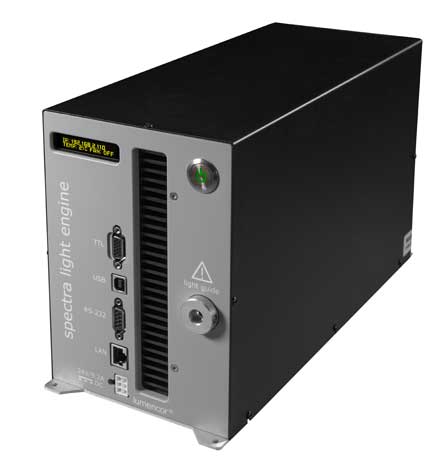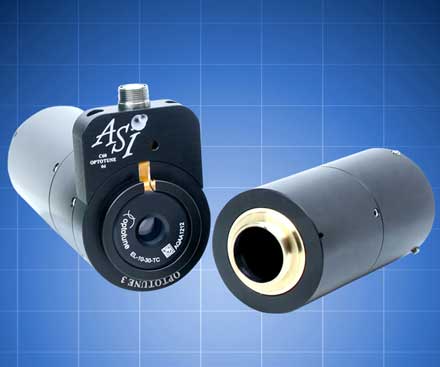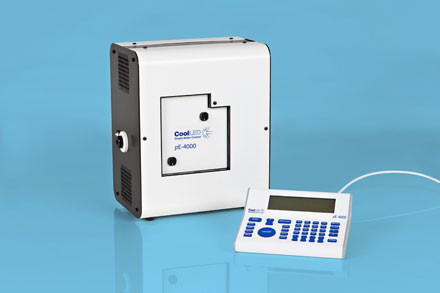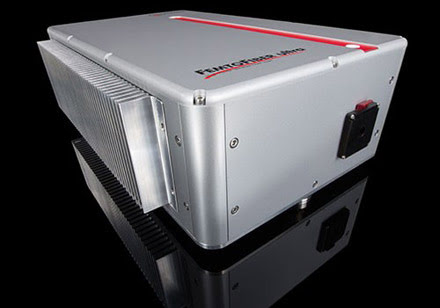|
Wednesday, April 25, 2018
|
|

|
|
|
Monthly newsletter focusing on how light-based technologies are being used in the life sciences. Includes news, features and product developments in lasers, imaging, optics, spectroscopy, microscopy, lighting and more. Manage your Photonics Media membership at Photonics.com/subscribe.
|
|
|
|
sponsor
|

|
|
Vying for Dominance: Swept-Source vs. Spectral-Domain OCT
At its core, OCT is a low-coherence interferometric technique. The earlier versions used time-domain interferometry. However, the technique really came into its own when Fourier-domain versions of OCT were introduced. In this implementation, interference of different wavelengths or colors illuminating the sample are recorded separately, and a depth profile is obtained using Fourier transformation to convert the data from wavelength domain to image domain.
|
|
|
|
|
|
Multiphoton Microscopy Sets the Standard for Live-Cell Imaging
Multiphoton imaging is widely used for live-cell imaging. Many of the applications are in neuroscience, where the trends involve deeper imaging using longer wavelengths. These trends are the leading drivers behind the latest generation of ultrafast lasers based on ytterbium (Yb) fiber. However, there are numerous other applications far outside the field of neuroscience, and these are often served with traditional titanium:sapphire (Ti:S) ultrafast lasers.
|
|
|
|
|
|
 SMS Reveals Hidden Behaviors
SMS Reveals Hidden Behaviors
Single-molecule spectroscopy is gaining traction in a wide range of fields, from DNA sequencing to understanding how cells, drugs, genes or proteins interact. The potency of single-molecule techniques is their capability to attain the ultimate limit of sensitivity — a single emitter. No averaging over a large number of molecules is required, since the properties of just one molecule are measured at a time.
|
|
|
|
|
|
 Eight Bright Solid-State Light Sources for Fluorescence
Eight Bright Solid-State Light Sources for Fluorescence
Lumencor Inc.
Best-in-class SPECTRA III Light Engine provides
- Eight independent, solid-state light sources for high-brightness fluorescence needs
- Spectrally optimized DAPI, CFP, GFP, YFP, Cy3, mCherry, Cy5 and Cy7 excitation
- ~500 mW per colorband out of a standard liquid light guide
- Optical power stabilization for exceptional reproducibility and quantitative accuracy
- Ideal for high brightness demands like spinning disk confocal microscopy
Visit Website
Request Info
|
|
|
 Tunable Lens Focus Device
Tunable Lens Focus Device
Applied Scientific Instrumentation Inc.
Our Tunable Lens system consists of the C60-TUNELENS- 4F assembly along with the TGTLC card of the TG1000 controller. The system lets user remotely control the focus of the system without moving the objective. C-Mounts are used to mount the C60 Tunable 4F assembly to the imaging camera and to the microscope’s photo port. The C60-TUNELENS-4F assembly houses a shape changing polymer lens or tunable lens.
Visit Website
Request Info
|
|
|
|
|
|
 NEW pE-4000 with Enhanced Intensity
NEW pE-4000 with Enhanced Intensity
CoolLED Ltd.
The CoolLED pE-4000 now benefits from our award winning sustainable Green technology. This provides enhanced intensity where it matters for imaging and dramatically reduces the power consumption. Every pE-4000 boasts 16 selectable LED sources arranged conveniently in 4 channels, using our patented wavelength grouping concept.
Visit Website
Request Info
|
|
|
 Powerful Femtosecond Fiber Lasers
Powerful Femtosecond Fiber Lasers
TOPTICA Photonics Inc.
The FemtoFiber ultra series are compact lasers that work reliably after a push-button start. No water-cooling is required since simple air-cooling is sufficient for stable operation. These cost-effective and compact laser solutions provide femtosecond pulses with high average power and excellent beam quality.
Visit Website
Request Info
|
|
|
|
|
|
The GENESYS project, which was granted £500,000 ($697,000) in funding from Innovate UK, applied Optalysys’s optical processing technology to perform large-scale DNA sequence alignment. The collaboration set out to provide a scalable, energy-efficient solution to this challenging high-performance computing task.
|
|
|
|
Researchers at the University of Central Florida are using single-molecule pull-down (SiMPull) assays to understand and diagnose Parkinson’s disease.
|
|
|
|
How the Metalens Will Transform Lens Technology and Everyday Devices
Wed, May 9, 2018 1:00 PM - 2:00 PM EDT
Presented by Federico Capasso, whose work in quantum design led to the realization of the quantum cascade laser, this webinar will discuss monochromatic and achromatic metalens design, applications, and advantages over conventional lens technology. Capasso will discuss applications that his group is currently working on, including a collaboration with Massachusetts General Hospital.
|
|
|
|
Features
Spectroscopy and Multispectral Imaging for Diagnosis; Light Technology for Botany; Patient-Specific Laser Additive Manufacturing; Biomedical Augmented Reality
Photonics Media is currently seeking technical feature articles on a variety of topics for publication in our magazine BioPhotonics. Please submit an informal 100-word abstract to Associate Managing Editor Marcia Stamell at [email protected] or use our online submission form www.photonics.com/submitfeature.aspx.
|
|
|
|